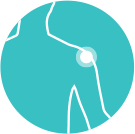Shoulder Dislocation
A dislocated shoulder arises when the ball of the joint becomes detached from the shoulder socket. The dislocation may be complete or partial. Partial dislocation is also known as shoulder subluxation. Once a shoulder has been dislocated, it tends to become vulnerable to repeat occurrences. This is described as chronic or recurrent dislocation
What Causes a Shoulder Dislocation?
Shoulder dislocation most commonly arises from a specific injury or trauma to the joint, causing tears to the labrum, which is a strong rim of tissue around the socket that helps to hold the shoulder in joint.
Injuries arising from repeated overhead motions, playing contact sports or in the workplace can all cause dislocation. Some individuals who are unusually flexible may experience dislocation even without an injury.
What are the Signs and Symptoms of a Dislocated Shoulder?
Patients will experience pain, which may be severe, along with a limited range of motion and a persistent sense of instability in the joint. Patients may also experience numbness and general weakness along with repeated instances of dislocation.
How is the Condition Diagnosed?
Mr Soong Chua and his team will begin with your medical history and a physical examination to assess your pain and range of movement before moving onto imaging tests such as x-rays, ultrasound or an MRI scan.
What are the Treatment Options for a Dislocated Shoulder?
Mr Soong Chua may initially suggest non-surgical approaches to shoulder stabilisation such as:
- Rest and activity modification
- Physiotherapy to try to relieve the pain
- Anti-inflammatory medication for pain management including non-steroidal anti-inflammatory drugs
However, shoulder dislocation often requires surgery to repair the damaged joint and Mr Soong Chua and his team will consider a range of surgical options.





